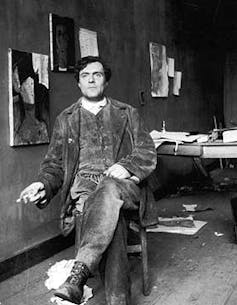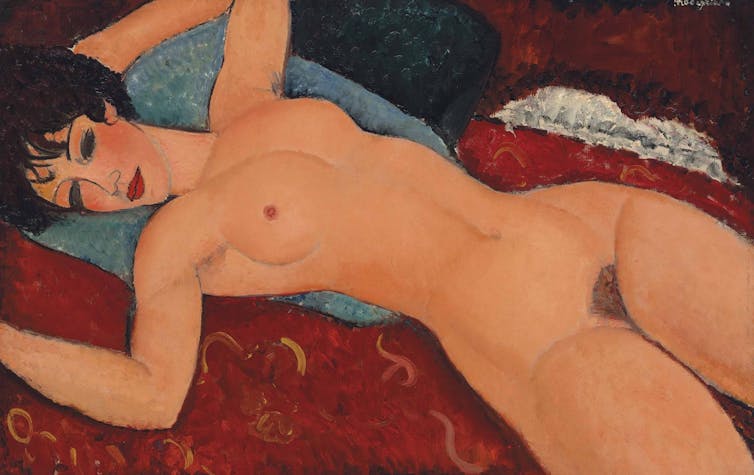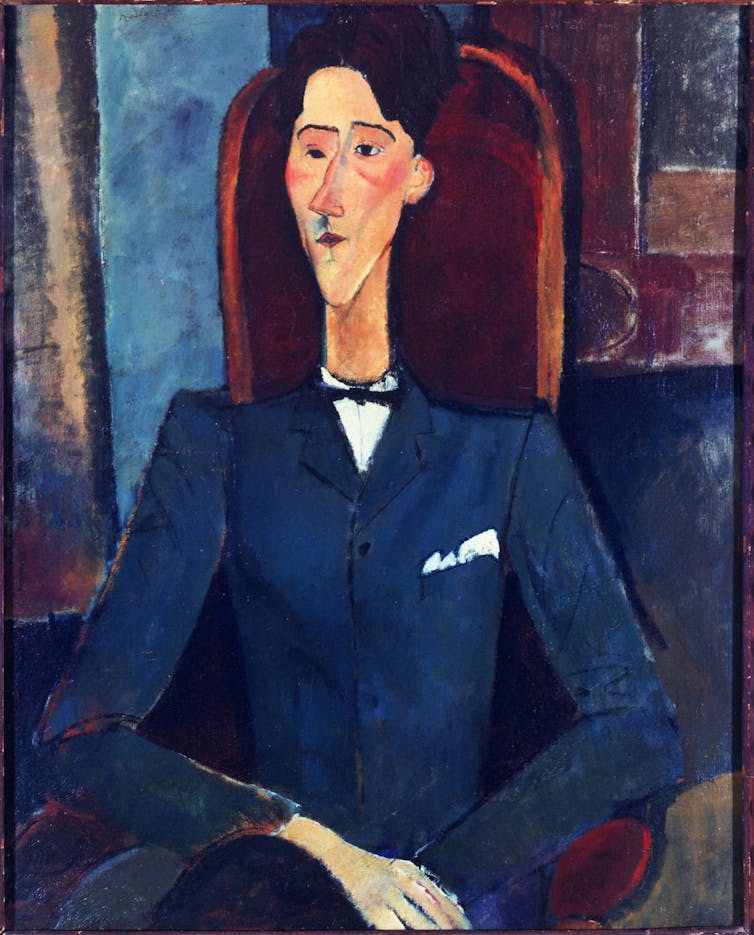Source: The Conversation (Au and NZ) – By Ted Snell, Honorary Professor, Edith Cowan University
Review: Maverick Modigliani, directed by Valeria Parisi.
It is not surprising we are fascinated by the story of Amedeo Modigliani, a boy from Livorno who arrived in Paris in his early 20s determined to make a reputation as an artist. His story could well have emerged from an all-night script session on a Hollywood backlot.
In the heady creative cauldron of sin-city, surrounded by artists from all over Europe (now grouped together as the School of Paris), a devastatingly handsome young man flees his family to find fame. Quickly seduced by its licentiousness, he lives life to the full.
Fuelled by alcohol and drugs, he paints furiously. His affairs are legendary, most famously with the poets Anna Akhmatova and Beatrice Hastings.
In a career of 15 years, he painted over 400 pictures, made a handful of stone carvings, and produced an archive of drawings before succumbing to tubercular meningitis at the age of 35 in 1920. Two days later, his pregnant young lover, fellow painter Jeanne Hébuterne, took her own life.Although her family refused to allow the couple to be buried together, in 1930 they finally relented and they now lie together under his epitaph “Struck down by Death in the moment of glory” and hers “Devoted companion to the extreme sacrifice”.
Life on the screen
To memorialise Modigliani on the centenary of his death, Italian director Valeria Parisi created the documentary Maverick Modigliani, interviewing historians, artists, forgers and curators about his life and his legacy.
Modigliani’s story has been brought to the screen before.

One of the most visually stunning is Modì (1989) directed by Franco Brogi Taviani in 1989, with Richard Berry in the lead role. Taviani explores the artistic milieu of Paris with relish, detailing the creative exchange that lured artists from around the world.
When Martin Scorsese was planning a movie about Modigliani in the early 1980s, he cast Al Pacino, which sadly never made it to the screen.
Mick Davis’ eponymous film, the 2004 turkey starring Andy Garcia as our hero and Elsa Zylberstein as Jeanne, highlighted the dangers of making the wrong casting choice.
Unfortunately, documentaries don’t provide the same emotional engagement as a good biopic like Modì, and Maverick Modigliani has all the genre’s standard tropes.
A group of talking heads pontificating about the artist and his work interspersed by footage and still images of Parisian life then and now does little to convey the vibrancy and energy of his extraordinary life.
Read more: Friday essay: the Melbourne bookshop that ignited Australian modernism
The scripted voice over, delivered in the guise of Jeanne doesn’t work. If Jeanne was more confessional, more probing, even more salacious, it might have drawn us into their world. Instead, her sad story is obscured by her thoughts on events that happened after she was dead and seems strangely disengaged and disingenuous.
The film does little to interrogate Modigliani’s work.
Instead, we are taken on numerous sidetracks to document student pranks about lost sculptures and an interview with a forger who describes how easy he was to copy. While his life is a Greek tragedy, in this film Modigliani remains a rather bland character.
Elegant revision
Modigliani was a stylist who embraced the current interest in the art of other exotic cultures and antiquity to create an elegant revision under the guise of modernism.
Though shocking to the Parisian public of 1917, his nudes are updated versions of his Renaissance precursors, fashionably hip and rendered in bold flat colour. They are the perfect synthesis of what was happening around him. Modì was a sponge, soaking up the influences of African art, Picasso, Matisse, and Constantin Brâncuși. There is no “School of Modigliani.”

For Nu couché, painted in 1917, his influence was clearly Édouard Manet’s Olympia. However, his similarly supine model seems much less in control as she lies back exposing herself. Her eyes are empty sockets, she is neatly trimmed, available; she is a pinup.
In so many ways it is an uncomfortable painting with none of the inference, subtlety or sophistication of its precursor. The pose is unconvincing, the face is a mask, yet the message of this “portrait” is clear.
It is undoubtedly why it caused a bidding war at Christie’s in 2015 and set a record price for the artist of US$170.4 million. But as a painting it is a mediocre effort.
That said, there are a few real portraits in his oeuvre, works that do extend the genre. His remarkable images of fellow artists Moïse Kisling, Chaïm Soutine and Jean Cocteau are graphically strong and insightful. It is a pity he didn’t show his female models the same respect.

Obscuring the true man
In the end credits, Parisi adds a text explaining she didn’t take sides in the debates over Modigliani’s legacy: which paintings were considered fakes, which are thought to be overly cute, and which stand among the great portraits of the century.
“We have accepted and reported the opinions and statements made by the historians, experts and curators we interviewed in a neutral way,” she says.
Perhaps this is the problem. We know very little more about the artist or his work than when we started. Parisi doesn’t stake a claim for Modigliani or try to convince us one way or the other. For anyone who knows a little of the back story and has scanned a few art books, there isn’t much more to be gained from Maverick Modigliani. What a shame.
Maverick Modigliani is in limited release this weekend.
– ref. Maverick Modigliani review: unimaginative documentary avoids the dramatic truths – https://theconversation.com/maverick-modigliani-review-unimaginative-documentary-avoids-the-dramatic-truths-154072







